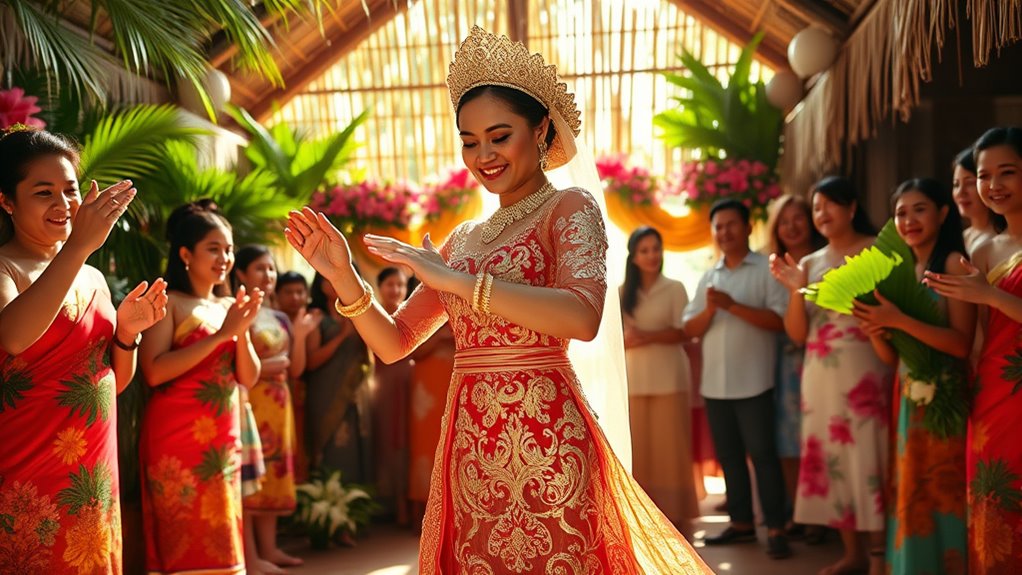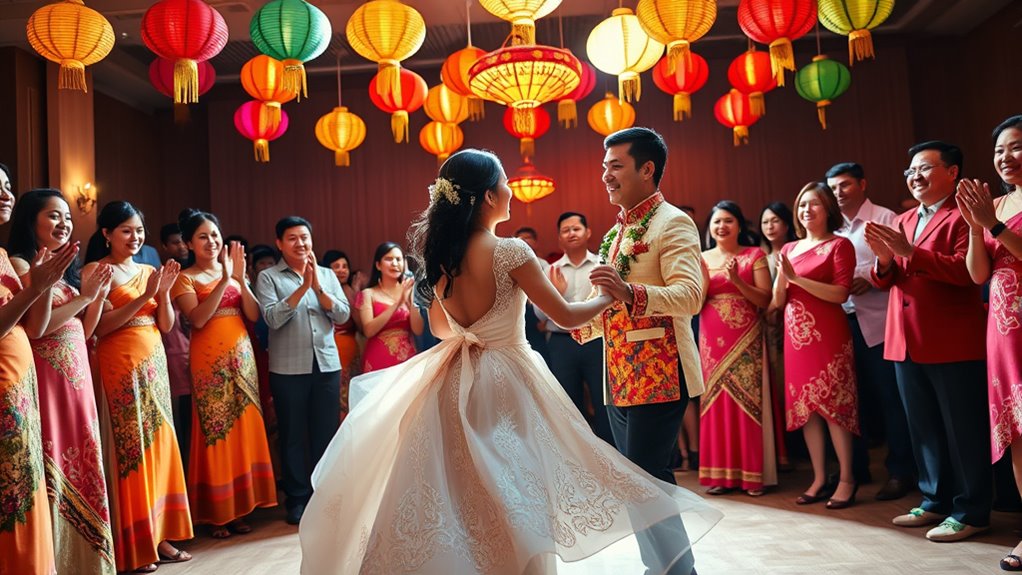When attending a traditional Filipino wedding dance, you can expect lively music, colorful decorations, and joyful rituals like the Money Dance and Shoe Dance. Guests actively participate by pinning money to the couple and helping them with playful shoe exchanges, symbolizing blessings and partnership. The dance highlights cultural heritage with instruments like kulintang and rondalla, creating an authentic, warm atmosphere. If you keep exploring, you’ll discover even more meaningful customs that make Filipino wedding celebrations truly special.
Key Takeaways
- Expect lively entrance dances featuring the bride and groom amid cheers and traditional music.
- Anticipate the Money Dance where guests pin cash onto the couple for blessings and prosperity.
- Look forward to playful activities like the Shoe Dance, symbolizing partnership and humor.
- Traditional Filipino instruments, such as kulintang or rondalla, accompany the dance, adding cultural authenticity.
- The dance reflects community support, love, and rich cultural traditions, creating a joyful, festive atmosphere.

Have you ever wondered how Filipino culture celebrates love and unity through dance? When you attend a traditional Filipino wedding, one of the most enthralling parts is the wedding dance, which beautifully embodies Filipino wedding customs and holds deep cultural significance. These dances aren’t just performances; they’re meaningful rituals that symbolize the couple’s journey and their community’s support. Expect to see lively, rhythmic movements that reflect centuries-old traditions, all infused with warmth and joy. The dance often begins with the bride and groom making their entrance, accompanied by cheers and applause from family and friends, setting a festive tone that underscores the importance of community in Filipino culture.
Filipino wedding dances celebrate love, tradition, and community with lively, meaningful rituals filled with joy and cultural pride.
As the wedding progresses, you’ll notice the significance of the “Money Dance,” a popular Filipino wedding custom. During this dance, guests pin money onto the couple’s clothing, symbolizing their blessings for prosperity and happiness. It’s a vibrant, interactive moment that emphasizes generosity and communal support. The act of pinning money is more than just a gift; it’s a cultural gesture steeped in the belief that collective well-wishes help ensure the couple’s future is filled with abundance. Watching this dance, you’ll realize it’s a way for everyone to participate directly in celebrating the union, making the event more personal and heartfelt.
Another key aspect of the wedding dance is the “Shoe Dance,” where guests place their shoes in the center of the dance floor, and the bride and groom take turns trying to put on each other’s shoes. This playful activity symbolizes the couple’s partnership and willingness to support one another through life’s challenges. It’s also a reflection of Filipino hospitality and humor—lighthearted moments that bring everyone closer. Throughout the dance, traditional Filipino music and folk songs might be played, adding authenticity and cultural depth to the celebration. Additionally, traditional Filipino music such as kulintang or rondalla instruments often accompany these dances, highlighting the Philippines’ rich musical heritage.
Expect the atmosphere to be lively, with dancers moving to the beat of traditional instruments like the kulintang or rondalla, which highlight the Philippines’ rich musical heritage. The dance isn’t just entertainment; it’s a meaningful expression of love, unity, and community bonding. As you witness these customs, you’ll understand how Filipino wedding dances serve as a vivid reminder of the importance of family and tradition. They symbolize not only the couple’s union but also the collective hopes and blessings of everyone present, making the celebration deeply rooted in cultural significance that resonates long after the dance ends.
Frequently Asked Questions
How Long Does a Traditional Filipino Wedding Dance Typically Last?
A traditional Filipino wedding dance usually lasts about 15 to 30 minutes, depending on the number of dance variations and cultural significance involved. You might see lively performances like the Tinikling or Pandanggo sa Ilaw, which highlight Filipino heritage. These dances celebrate unity and joy, making the duration a reflection of the couple’s cultural roots and the festivities’ overall significance. Expect a vibrant, meaningful experience that honors tradition.
Are There Specific Songs Traditionally Used for Filipino Wedding Dances?
Imagine you’re at a Filipino wedding, and the bride and groom dance to “Ako’y Sa’yo, at Ikaw’y Akin.” This song holds deep cultural significance, symbolizing love and unity. In traditional Filipino wedding dances, song selection is thoughtfully made to reflect cultural values and emotional connection. You’ll often hear folk songs or romantic tunes that enhance the cultural atmosphere, making the celebration meaningful and memorable.
Who Usually Leads the Wedding Dance in Filipino Culture?
In Filipino culture, the bride and groom usually lead the wedding dance, symbolizing their new partnership and unity. This act holds cultural significance, emphasizing their central role in the celebration. They often perform traditional dance styles like the Tinikling or modern adaptations, showcasing Filipino heritage. As you participate, you’ll appreciate how this dance reflects cultural values of community, love, and shared joy, making the occasion truly meaningful.
Can Non-Filipino Guests Participate in the Wedding Dance?
You can definitely join in the wedding dance as a guest. Your participation reflects the warmth and inclusivity of Filipino culture, enhancing the ceremony’s cultural significance. Non-Filipino guests often feel welcomed to dance, celebrate, and connect with the community. It’s a fun way to show respect and appreciation for the tradition, making the event more memorable for everyone involved. Just follow the lead and enjoy the lively, joyful atmosphere!
What Attire Is Traditionally Worn During the Wedding Dance?
You’ll be dazzled by the vibrant Filipino wedding attire during the traditional dance. Guests and participants typically wear Filipino wedding attire or traditional dance costumes, showcasing bright colors and intricate designs. Men often sport barongs, while women wear elegant mestiza dresses or terno with butterfly sleeves. These traditional costumes capture the rich culture and history of the Philippines, creating a lively, colorful atmosphere that’s impossible to forget.
Conclusion
A traditional Filipino wedding dance is a heartfelt celebration of love, culture, and community. As you participate or observe, you’ll see how these dances embody unity and joy, making your special day even more memorable. Remember, “A joyful heart makes a cheerful face,” so embrace the lively spirit and let the dance reflect the love and happiness you share. Truly, these moments become treasured memories that last a lifetime.









